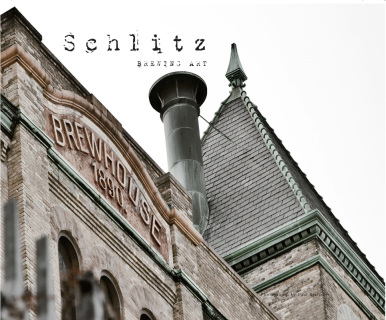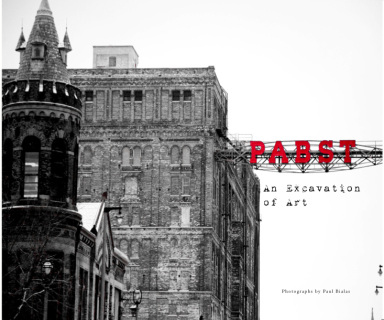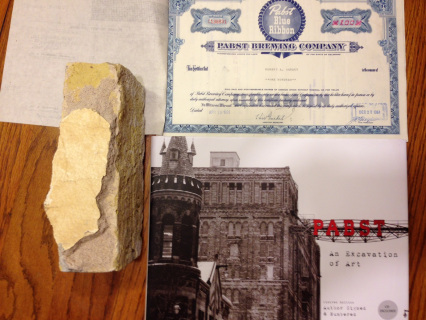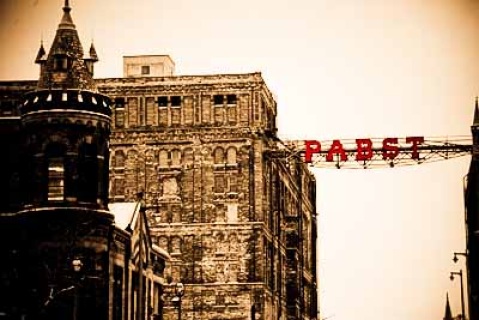SCROLL DOWN for ultra rare items...
After checkout, select "Pay by Checkout Express" On Bottom to Pay by Credit Card"



Be the first to received the new revised copy which for the first time includes 40 extra pages of the rarest historical documentation!
A signed copy of the book along with an interview CD. The book is 228 revised! pages with introduction by August U. Pabst. Includes unused Pabst beer label as well. Free Shipping! Is signed and numbered with dust jacket.

A signed copy of the book along with a 80 minute 8 track interview CD. The book is 228 pages revised with introduction by August U. Pabst. Be the first to receive the revised edition with 40 extra pages of rare historical documentation! 1 original 1960's Pabst Stock Certificate. 1 Authentic Pabst Job Application. Price includes shipping. Includes two 1970 vintage Pabst beer coasters and a vintage unused Pabst beer label. 2nd edition revised. This item is now limited to the next 50 orders as the stock certificate supply will be gone forever when they sell out! This package no longer includes a cream city brick.
17 card pre 1920 post card set (classic remakes: Milwaukee)
Pre Prohibition Cream City Brewing Milwaukee 12" Tray (Faded)
The condition is far from perfect for this pre 1918 Milwaukee 12" beer tray. Such a cool logo. Guaranteed old. Ships free
Schlitz Soldier self framed tin, Pre prohibition era- pre 1918 (Here's Health) 21"x9.5"
Very rare, yet not in perfect condition. measure's 21"x9.5". Guaranteed old and original
Pre Prohibition Pabst Brewing Tray (1912?)
As pictured, measure 18" long, I believe it is 1912. One with a yellow hue sold in Dan Morean's auction for $2700 in Nov. 2023. Hard to find piece with some obvious issues. Ships free
Bergner & Engel Brewing Co. Pre Prohibition Corner Sign, Philadelphia, PA (Cut/Rust)
Measures 19"x29". Appears to have left and right slightly cut. If you look at the letters, you'll see they are slightly cut off, I'm guessing left and right were trimmed, possibly top and bottom, I'm not sure. Shows rust and bends, but is very old and possibly one of a kind brewing history from Philadelphia. Guaranteed old and original. Once one of the biggest breweries in the country in its time. Extremely rare Amazing piece. Ships free.
Here is some history....
Charles Wolf, a sugar refiner in the neighborhood, had an employee named George Manger, who was a brewer by trade. Manger obtained some of the yeast and began making larger batches in a brewery on New Street near Second. Around the same time, Charles Engel, also a brewer, emigrated and found work in Wolf’s refinery. In 1844 Engel and Wolf brewed their first batch of lager beer in the sugar pan and stored it in sugar hogsheads to be shared with their friends.
The same year, the refinery was destroyed by fire and Mr. Wolf went into the brewing and distilling business at 354 Dillwyn Street. Engel & Wolf’s brewery became a popular resort of the Germans of Philadelphia who were known to “drink the brewery dry.” Since lager yeast requires colder fermenting and aging (lagering) conditions than ale yeast, ice houses became more important than ever. Vaults were dug in 1845, and with the increasing number of German immigrants, Mr. Wolf expanded the brewery. In 1849 he purchased a property on the Schuylkill River known as Fountain Green where lager beer vaults extending over 200 feet were dug. For several years wort was hauled by ox teams from Northern Liberties to the vaults at Fountain Green, a distance of about three miles. Over the next few years a new brewery was erected on the site, modern and complete in every way. It was the first large-scale lager brewery in the United States.
Fountain Green was an ideal location. It was out in the country where there was plenty of room. There were springs on the property. Wolf’s farm was just up the road. The banks of the river are composed of Wissahickon Schist, which is fairly soft and easy to dig. In winter, being right on the river was an advantage when harvesting ice for refrigeration. In addition, the Philadelphia & Reading Railroad served the brewery with the “Engel Side” spur.
Philadelphia developed along both of it’s rivers, but along the more navigable Delaware, ship building, shad fishing, industry and commerce were most abundant. Philadelphia’s reputation as “The Workshop of the World” was earned in large part by the “river wards” of Northern Liberties, Kensington, and Frankford. These neighborhoods were literally teaming with breweries. When lager beer began to catch on, many brewers rented beer vaults along the Schuylkill River, and in the area that came to be known as Brewerytown.
Engel & Wolf enjoyed success, but in 1870 the property was acquired by the Fairmount Park Association. The city had just built the Fairmount Water Works, the most technologically sophisticated, state of the art municipal water pumping facility in the nation, and to ensure water quality, removed all industry from the Schuylkill River for a distance of five miles upstream. At this time Mr. Wolf retired and his partner joined Gustavus Bergner to create the Bergner and Engel Brewing Company.
Gustavus’ father Charles had started a brewery on North Seventh Street in the Northern Liberties in 1852 which Gustavus took over upon his father’s death. In 1857, Gustavus erected a brewery at 32nd & Thompson Streets, an address that would become the heart of Brewerytown. Interestingly enough, Brewerytown was essentially up and over the river bank from the old Engel and Wolf brewery.
The earliest picture of Brewerytown that I have been able to uncover is based on four Hexamer Surveys that were made in 1868. They show thirteen breweries, one of which had a distillery, three “lager beer vaults,” including one owned by Peter Schemm, a row of dwellinghouses with beer vaults beneath them, a number of stables and at least three or four brewery saloons.
Beginning in the 1870’s ice-making and artificial refrigeration technology radically altered the equation. It made proximity to river ice of little importance. Huge fermenting and storage houses could be constructed anywhere and they could maintain cold temperatures year round. Where brewers had been bound to brew only during the colder months, it was now possible to brew year round. With the exponential increase in popularity of lager beer, artificial refrigeration was the answer to a dream.
Some brewers who had rented vaults in or near Brewerytown built breweries there. Others refrigerated their breweries and no longer needed to rent vaults. According to the list of projects executed by brewery architect Otto Wolf, the breweries were continually being altered and enlarged to accommodate the trade. The trend was for the brewers to go west to Brewerytown from the river wards, but some left Brewerytown and went into business in Kensington.
The Bergner & Engel B.C. was one of the largest brewers in the country. B & E won the Grand Prize at the Centennial Exposition held in Philadelphia in 1876 and the Grand Prize at the Paris Exposition in 1878. Their beer was shipped across the country, and around the world. Gustavus Bergner was very active in the United States Brewers Association, the Philadelphia Lager Beer Brewers Association, and the Philadelphia Brewmasters Association. B & E was the largest brewer in Philadelphia, and eventually absorbed three other Brewerytown breweries: Mueller, Eble & Herter, and Rothacker.
When prohibition loomed on the horizon, Mr. Bergner had significant political clout and did everything humanly possible to prevent severe trauma to the brewing industry, not only in Philadelphia, but throughout the nation. At first, the brewers thought they would not be affected. After all, beer was hardly intoxicating when compared with liquor. Then they thought if they reduced the alcohol to 2.75% they could still sell their product. Anti-dry forces in Congress attempted to make beer available by physicians’ prescription. But in the end the Federal Government established the legal limit for “near beer” at one half of one per cent alcohol.
Prohibition devastated the brewing industry. It was such an unpopular law, that for some time, things just went on as they had before. Most of the city’s brewers were law-abiding German Americans. They could not fathom a world without a foamy seidel of beer. Not only that, but they would have to become criminals in order to make beer, their “staff of life.” Legally, they brewed “near bear,” and made soda. They made malt extract for the malt shop as well as for the home brewer, and sold yeast and ice. The Poth brewery became home to the Cereal Beverage Company, the local distributor of Anheuser-Busch’s Bevo. Due to demand and profitability, however, many continued to produce “high-octane” beer, even after being raided several times, sometimes while they were involved in litigation.
The government targeted the biggest guy on the block and made an example of B & E. After being raided, B & E continued to make beer. It was a case of the public and business community defying a terribly unpopular law and the government responded with a vengeance. And while B & E had lots of legal tricks up its sleeve, in the end the government prevailed and shut them down. Breweries throughout the city were padlocked. And in December of 1928, as police sewered nearly a million gallons of B & E beer, officers were quoted as saying “B & E made the best beer in the city.”
Solano Brewery Steam Beer Pre prohibition Tin Corner Sign (CUT) 17"x24"
Guaranteed old and original. Excellent graphics, this was cut down from its original form, notice the R in beer is cut and at the top. Graphics are still stunning, it is mounted on a corner sign frame and Indian shows great. The few fully intact that have sold exceed 10K in uncut condition. If you'll never spend that, but still want one this is your shot. Ships Free. Vallejo California. 17"x24"
Here is a bit of history from the current Solano Brewing company, the original was a victim of Prohibition and closed in 1918 and is the era this corner sign is from (Pre 1918):
1854 – The Solano Brewing Company was founded in 1854 by German immigrant, Charles Widenmann. The brewery gained popularity in the late 19th century and became renowned for its steam beer.
Charles and his brewers produced up to 6,000 barrels a year and had their own Malt House which sat between Georgia and York Street in Vallejo.
1918 – After 64 years of business, production came to a screeching halt when General Order No. 99 (Prohibition in the Navy) was sent out and ultimately forced Charles to shut down Solano Brewing Company in 1918.
After almost a century of dormancy, two Solano County natives, who unearthed the history of SBC, decided to pick up where Charles left off and re-imagined what Solano Brewing Company could become in this exciting new time of Craft Brewing.
2015 – In 2015, Randy Dawson and Sean Bonifacio collaborated with the goal of creating a local, excellent quality beer with hometown roots, the outcome was Solano Brewing Company, LLC. Fortunately, their paths crossed with Brian Bell and the fun began! Brian is our Head Brewer and has been the Catalyst to making SBC what it is today.
Solano Brewing Company currently brews and operates on a 20-acre parcel of land located at 5500 Weber Road in Vacaville.
1914 Schlitz War Atlas (Disconnected Pages) 13.5"x10"
Free shipping, many pages showing battle ship positions and Panama Canal updates
Kamm & Schellinger brewery pre prohibition lithograph print framed
Framed piece, has a slight tear in a few places, see upper middle. over 100 years old guaranteed authentic. Ships free. more photos available upon request
Cream City Brewing Company Tied House chair (Pickup Only - Waukesha, WI)
As pictured, very hard to find, pre prohibition chair. pickup only, Waukesha, WI
Pabst Tied House chair (Pickup Only -Waukesha, WI) 1890-1918
As Pictured, Guaranteed old and authentic (All my items are), pickup only, waukesha, WI
Schlitz Tied House chair (Pickup Only - Waukesha, WI)
As pictured, has a nice stamp, 1890-1918 Tied house chair, authentic. Pickup only
Jung Brewing Company Tied House chair (Pickup Only - Waukesha, WI)
Tied House pre prohibition chair, pickup only in Waukesha, WI, very sturdy in nice chaos. good stamp
Pabst Pre Prohibition Tied House chair (Pickup Only - Waukesha, WI)
As Pictured, sturdy enough to sit on, pickup only, dates 1890-1918
1912 Anheuser Busch Lithograph Advertising piece (Attack on an Immigration Train). SOLD
Price includes shipping, Guaranteed old and original. Around 22" long. Scene depicts Indians attacking a European family. The family is protecting the woman, children and beer:)
Miller Taste's Great - Less Filling Billboard from 1980s 9'x20'
Possibly the only surviving example of a Miller 1980s billboard that luckily was never put up. measuring 9'x20' roughly it ships for free.
The Budweiser Clydesdales 1980s unused billboard 9'x20' vintage old new stock
Free shipping, this is likely a sole survivor of the 1980s Budweiser billboards... measures 9'x20' guaranteed authentic and old
Hamm's People's Choice Billboard sign 9'x20' 1980s new old stock vintage beer
Very cool vintage billboard, it should have never been saved 40 years ago, but here it is..
This video clearly shows the rare items, although most are sold by now..
After checkout, select "Don't Have a Paypal Account" On Bottom to Pay by Credit Card"



